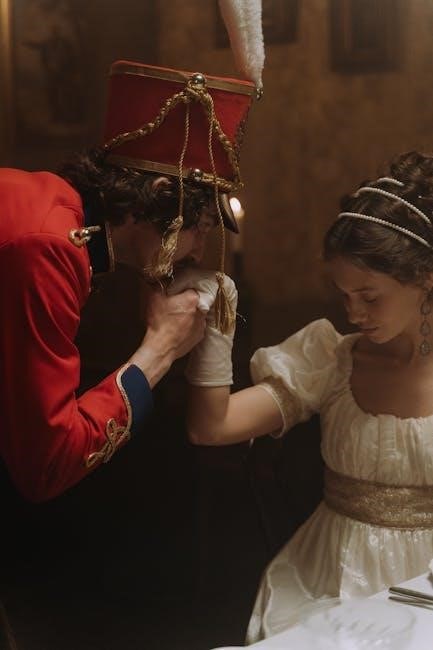A hilarious and dark musical comedy about ambition and love, set in Edwardian London. Based on a 1907 novel, it won the 2014 Tony Award for Best Musical, blending humor with intricate plots and memorable characters.
Overview of the Musical
A Gentleman’s Guide to Love and Murder is a Tony Award-winning musical comedy that masterfully blends wit, murder, and romance. Set in Edwardian London, it follows Monty Navarro, a charming but impoverished clerk, as he discovers he’s ninth in line to an aristocratic title. With a mix of dark humor and elegant music, the show explores themes of ambition, love, and class, featuring a standout performance by an actor playing multiple roles. Its clever plot and lively score have made it a modern theater classic.
Historical Context and Literary Background
A Gentleman’s Guide to Love and Murder is adapted from Roy Horniman’s 1907 novel Israel Rank: The Autobiography of a Criminal. Set in Edwardian London, the story explores themes of ambition, class, and morality during a period of rigid social hierarchy. The musical reimagines Horniman’s darkly comedic tale, blending it with a witty, music-hall-inspired score and clever storytelling. This adaptation brings a fresh perspective to the original novel’s satirical critique of aristocratic life, making it a unique blend of literature and theater.
Key Characters and Their Roles
Monty Navarro, a charming antihero, navigates love, murder, and family ambition. The D’Ysquith family, his aristocratic targets, and his love interests, Sibella and Phoebe, drive the story’s twists.
Monty Navarro: The Charming Antihero
Monty Navarro, the penniless clerk, discovers his aristocratic lineage and ninth place in line for the Earldom of Highhurst. Driven by ambition and revenge, he cleverly eliminates his relatives while maintaining charm and wit. His dual life as a commoner and potential nobleman creates a captivating dynamic, blending humor with dark motives. Monty’s journey from obscurity to power, intertwined with love interests Sibella and Phoebe, makes him a complex and intriguing antihero.
The D’Ysquith Family: Targets of Monty’s Ambition
The D’Ysquith family represents the aristocratic legacy Monty Navarro aspires to claim. As relatives standing in his way, they embody the class privilege he resents. Each family member, from the pompous to the eccentric, is systematically targeted by Monty in his calculated rise to power. Their comedic yet exaggerated portrayals heighten the dark humor, making their demise both shocking and absurd. The family’s downfall, orchestrated with wit and precision, underscores Monty’s ruthless determination to secure his inheritance.
Love Interests: Sibella and Phoebe
Monty Navarro’s journey is further complicated by his love interests, Sibella and Phoebe. Sibella, a vain and manipulative socialite, represents Monty’s desire for status and luxury, while Phoebe, kind-hearted and genuine, embodies his longing for true love. Their contrasting personalities create a moral dilemma for Monty, as he navigates his ambition alongside his emotions. Both women captivate him in different ways, driving the emotional depth of the story and highlighting the tension between societal expectations and personal desire.

The Plot: A Tale of Ambition and Murder
Monty Navarro, a charming antihero, discovers he’s ninth in line to an earldom. Driven by ambition, he cleverly eliminates relatives to claim the fortune and title, blending humor with darkness.
Monty’s Discovery and Rise to Power
Monty Navarro, a penniless clerk, discovers he is ninth in line to the D’Ysquith earldom after his mother’s death. This revelation ignites his ambition, driving him to eliminate the relatives standing between him and the title. With charm and wit, Monty navigates the complexities of high society, facing challenges from both his aristocratic targets and his own moral dilemmas. His journey from obscurity to power is marked by clever manipulation and ruthless determination, showcasing his transformation into a mastermind of both love and murder.
The Murders: A Series of Hilarious and Clever Crimes
Monty’s quest for the D’Ysquith title unfolds through a series of ingeniously planned and darkly comedic murders. Each crime is meticulously executed, blending humor with cleverness, as Monty outwits his unsuspecting relatives. From accidental drownings to dramatic explosions, the murders are both shocking and absurd, showcasing Monty’s resourcefulness. These acts of violence, though morally questionable, are presented with a light-hearted tone, making the audience laugh while marveling at Monty’s audacity and the twisted logic behind each killing.

Themes and Messages
Exploring ambition, love, and class, the musical delves into morality, questioning societal norms and the limits of desire, blending humor with dark undertones to provoke reflection.
Love, Class, and Morality in Edwardian Society
Set in Edwardian London, the musical critiques societal norms through Monty’s journey, highlighting class divisions and moral ambiguity. Love becomes a complex motivator, intertwined with ambition, as Monty navigates his rise. The D’Ysquith family’s aristocratic status contrasts sharply with Monty’s humble origins, exploring themes of social inequality. Morality is questioned through Monty’s actions, blending humor with dark undertones to challenge ethical boundaries. The musical reflects on the era’s rigid class structure and the lengths people go to for love and status, offering a satirical yet thought-provoking commentary on societal values.
The Balance Between Humor and Darkness
The musical cleverly balances humor and darkness, transforming murder into a comedic yet intriguing element. Monty Navarro’s charm and wit make his dark deeds entertaining, blending laughter with moral ambiguity. The show’s clever writing and charming score turn macabre acts into hilarious scenarios, creating a unique tonal harmony that captivates audiences. This balance allows the audience to laugh at the absurdity while reflecting on the moral implications, making it a standout blend of comedy and darkness.

Musical Elements and Style
A hilarious and dark musical comedy about ambition and love, set in Edwardian London. Based on a 1907 novel, it won the 2014 Tony Award for Best Musical, blending humor with intricate plots and memorable characters.
Music and Lyrics: A Blend of Comedy and Elegance
The musical features a sophisticated blend of comedy and elegance, with music by Steven Lutvak and lyrics by Lutvak and Robert L. Freedman. The score effortlessly shifts between witty, fast-paced numbers and poignant ballads, capturing the duality of Monty’s charming yet murderous nature. The music hall style adds a vintage flair, while the clever wordplay and satirical undertones in the lyrics highlight the show’s sharp wit. This harmonious balance of humor and refinement earned the musical widespread critical acclaim, solidifying its place as a modern theatrical masterpiece.
The Role of Music in Advancing the Story
The music in A Gentleman’s Guide to Love and Murder masterfully drives the narrative, revealing character depth and advancing the plot. Each song, from the witty “I Don’t Understand” to the poignant “Sibella,” serves a dual purpose: showcasing Monty’s evolution and propelling the story forward. The score’s clever use of tempo and tone mirrors the play’s dark humor and unexpected twists, while also highlighting the emotional stakes of Monty’s ambitions and romantic entanglements. This seamless integration of music and storytelling enhances the audience’s connection to the characters and their journey.

Legacy and Reception
A Tony Award-winning sensation, A Gentleman’s Guide to Love and Murder received widespread acclaim for its ingenious blend of humor and music, cementing its place as a modern theatrical classic.
Awards and Critical Acclaim
A Gentleman’s Guide to Love and Murder earned widespread critical acclaim and numerous awards. It won four Tony Awards in 2014, including Best Musical, Best Book, Best Direction, and Best Costumes. The show also received ten Tony nominations, making it the most-nominated production of the 2014 season. Additionally, it claimed seven Drama Desk Awards, four Outer Critics Circle Awards, and a Drama League Award for Best Musical. Critics praised its dark humor, clever plot, and exceptional performances, solidifying its reputation as a modern theatrical masterpiece.
Cultural Impact and Popularity
A Gentleman’s Guide to Love and Murder has left a lasting impression on theater audiences worldwide. Its unique blend of dark humor, witty dialogue, and elaborate plot twists captivated viewers, making it a favorite among both critics and audiences. The show’s popularity led to successful productions across the U.S. and internationally, showcasing its universal appeal. Its clever storytelling and memorable characters have resonated with diverse audiences, solidifying its place as a standout production in modern musical theater history, celebrated for its originality and entertainment value.
A Gentleman’s Guide to Love and Murder is a masterful blend of humor, intrigue, and elegance, leaving a lasting mark on modern theater with its timeless story and wit.
Final Thoughts on the Musical’s Significance
A Gentleman’s Guide to Love and Murder is a landmark musical that masterfully blends humor, darkness, and wit. Its clever commentary on class, morality, and ambition resonates deeply, offering a fresh perspective on societal norms. The show’s success, including its Tony Award wins, underscores its timeless appeal and artistic brilliance. By balancing outrageous comedy with poignant themes, it leaves audiences both entertained and reflective, solidifying its place as a modern theatrical treasure.
